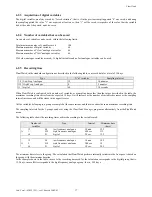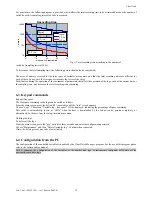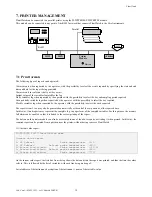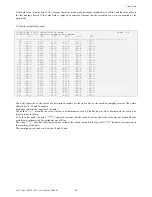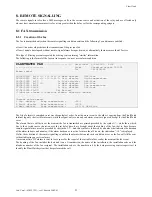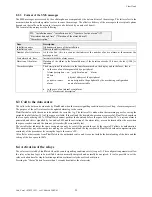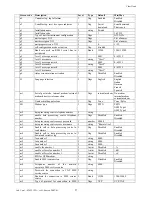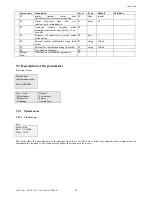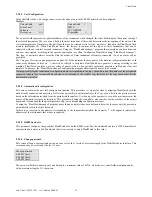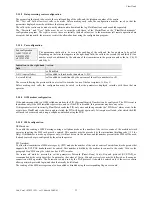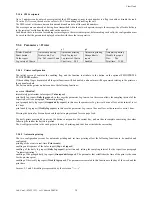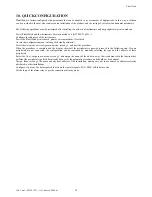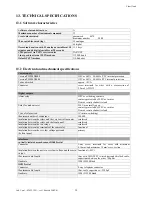
3ODQW:DWFK
Cod. Carel. +030221221 – rel. 1.0 dated 20/02/01
31
8QLW&RQILJXUDWLRQ
Using the fields in the
8QLWFRQILJXUDWLRQ
screen, the units present in the RS485 network can be configured.
Example
Unit cnf. add:
DGG
Type of unit
Category
'HVFULSWLRQ
11
Unit cnf. add: 1
IR32C
LT CABINET
Vegetables 1
The
DGGUHVV
field represents the physical address of the instrument, when changed, the other fields display the current setting of
the selected instrument. The
W\SHRIXQLW
field is the more important of these, and determines the recognition of the unit and the
correct management of the alarms. The unit types that can be selected are in fact the
³WHPSODWHV´
loaded in the PlantWatch flash
memory (maximum 32). When PlantWatch leaves the factory, it contains all the types of Carel instruments that can be
connected, with one
WHPSODWH
for each instrument. Using the “PlantWatch manager” program, these
WHPSODWHV
can be customised,
and new ones created, according to the specific application (see Chap. Configuring PlantWatch using “PlantWatch manager”).
The type of unit must always coincide with the model of Carel instrument effectively connected, if not, an alarm will be
generated.
The
&DWHJRU\
,
'HVFULSWLRQ
and progressive number
11
fields represent the user name of the machine (refrigerated cabinet, cold
room, air-conditioner, chiller, etc....), that will be referred to each time PlantWatch has to generate a message relating to that
machine. PlantWatch contains a pre-set series of names which, when suitably combined, generate a sufficiently clear unit
template. In any case, the “PlantWatch manager” configuration program allows specific names to be created.
Warning: modifying the installation's configuration data corresponding to the type, the address and the number of the peripherals
connected leads to, for reasons of data coherence, the deleting of the variable log; therefore, all the logs saved must first be
downloaded or printed.
$XWRPDWLFXQLWFRQILJXUDWLRQ
This screen activates the unit self-configuration function. This procedure is very useful when configuring PlantWatch with the
units already connected and operating. It offers the possibility to automatically set the
7\SHRIXQLW
field in the previous screen
based on the information received from the peripherals themselves. It is then up to the operator to set, on the previous screen, the
names of the units (category, description). This procedure, during the scan phase, also searches for the presence of the printer
board, and if found enables the printer presence flag (see corresponding configuration screens).
If, using the “PlantWatch manager” program, more than one
WHPSODWH
has been defined to describe the same unit, the procedure
automatically selects the first one found.
If there is no
WHPSODWH
in the memory corresponding to the instruments installed, the character ‘?’ will appear to indicate the
addresses of the instruments that are not recognised.
56EDXGUDWH
This parameter configures the speed that PlantWatch uses on the RS485 serial line; the standard baud rate is 19200, nonetheless,
some instruments only use 9600 baud, and thus it is necessary to adjust PlantWatch to this value.
&KDQJHSDVVZRUG
This screen allows a
SDVVZRUG
and
XVHUQDPH
to be set for the 3 levels of access envisaged in the PlantWatch user interface. This
screen can only be accessed by the level 3 user.
Change password
1: 00001 User1
2: 00002 User2
3: 00003 User3
The
SDVVZRUG
fields are numeric only and limited to a maximum value of 65536, while the
XVHUQDPH
fields are alphanumeric,
with a maximum length of 11 characters.
Содержание PlantWatch
Страница 1: ... 3ODQW DWFK QVWDOODWLRQ DQG XVHU PDQXDO ...
Страница 2: ......
Страница 4: ......
Страница 6: ......
Страница 47: ......

